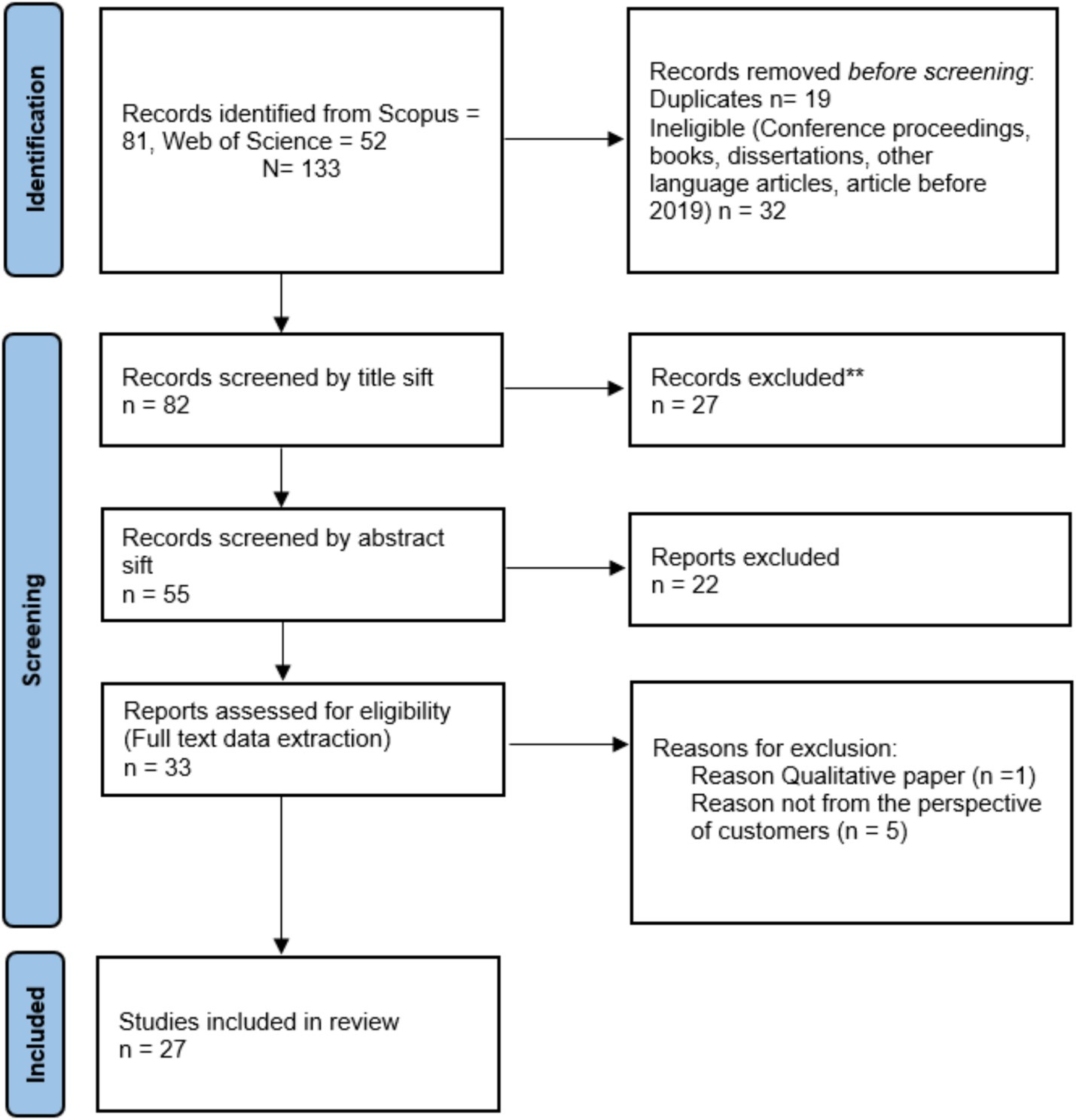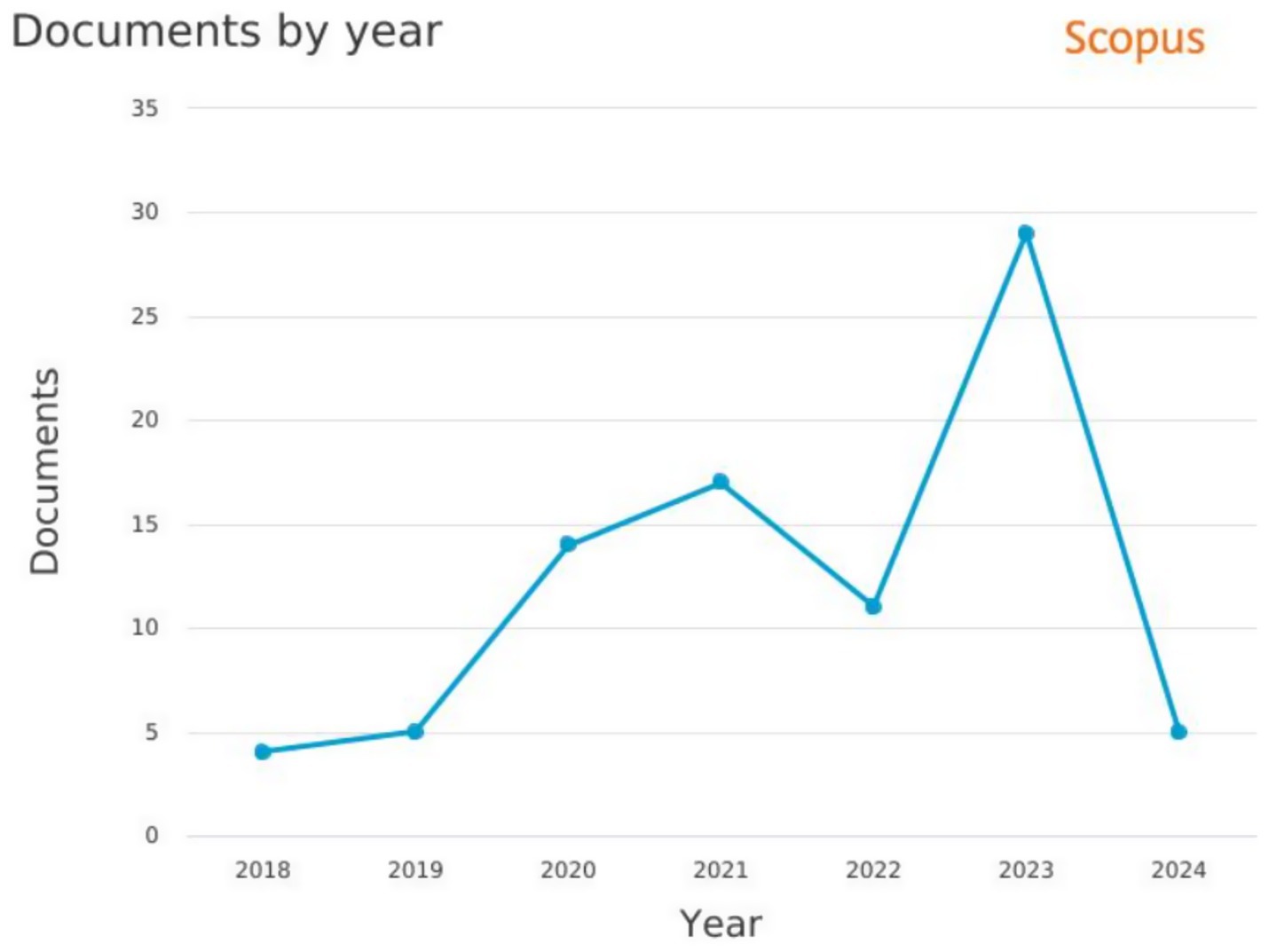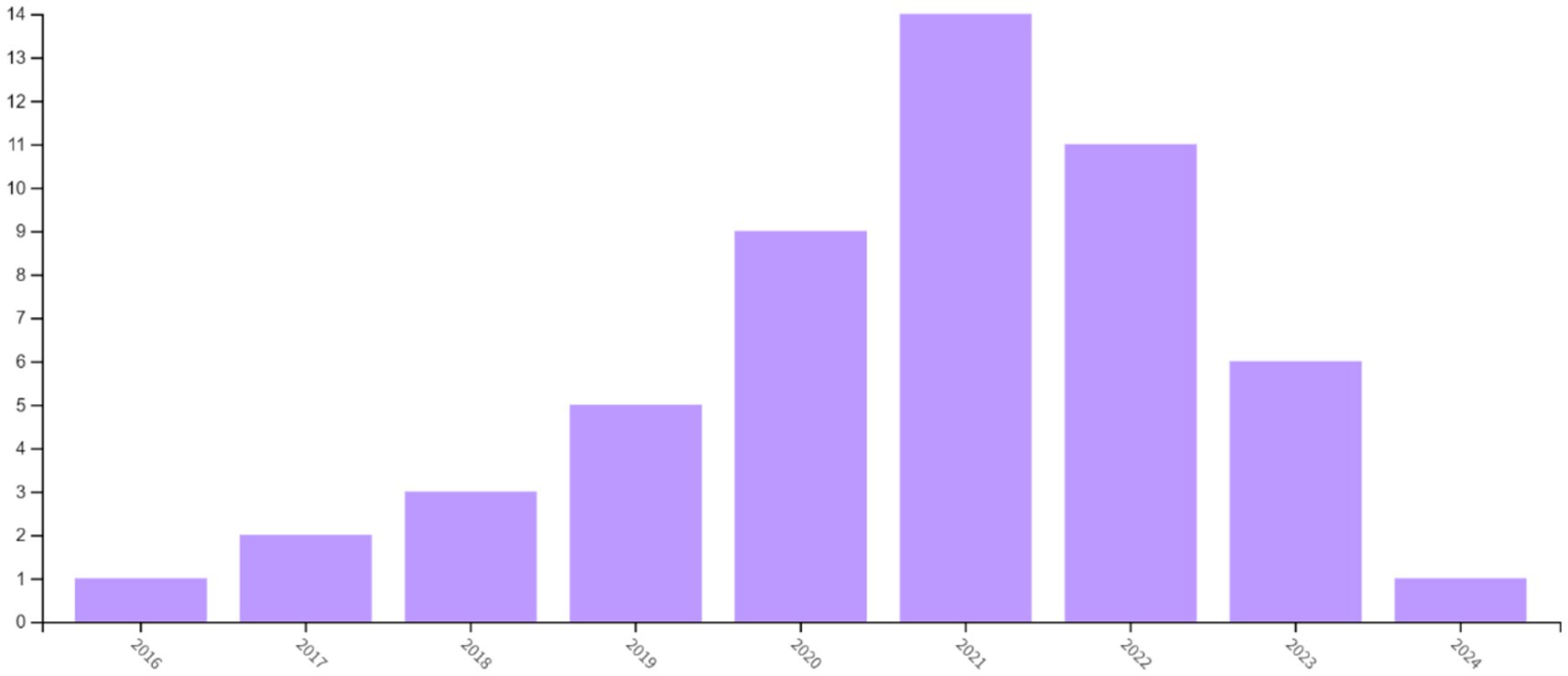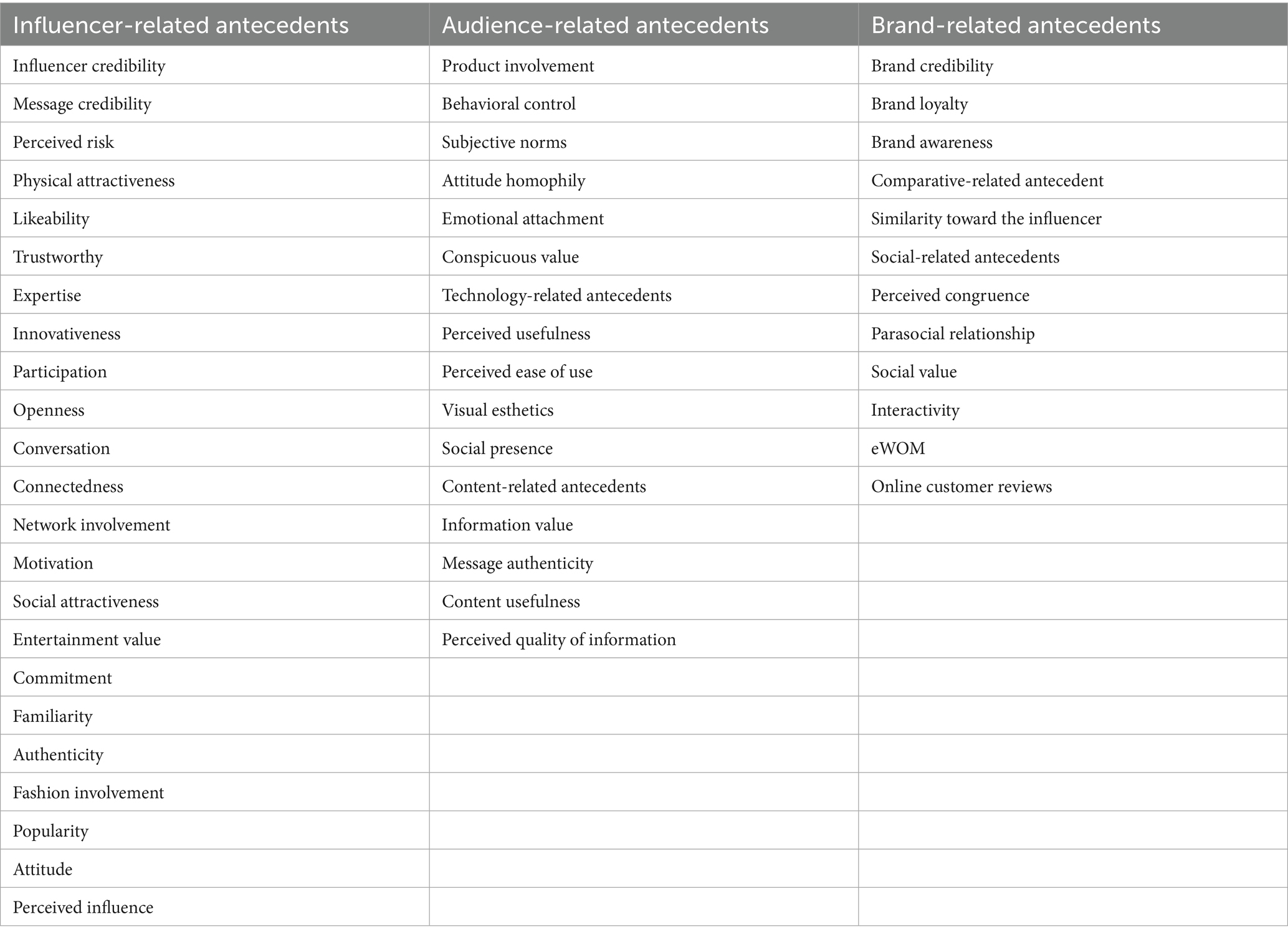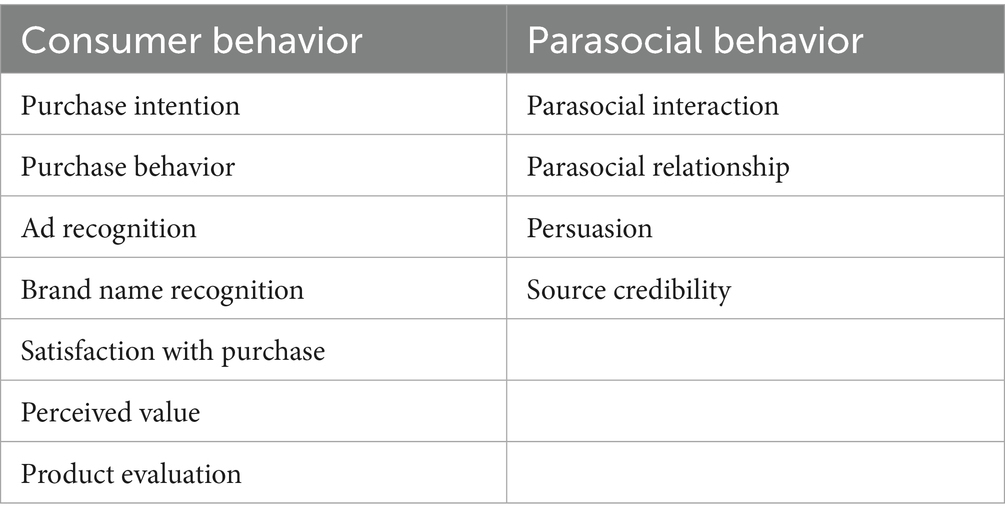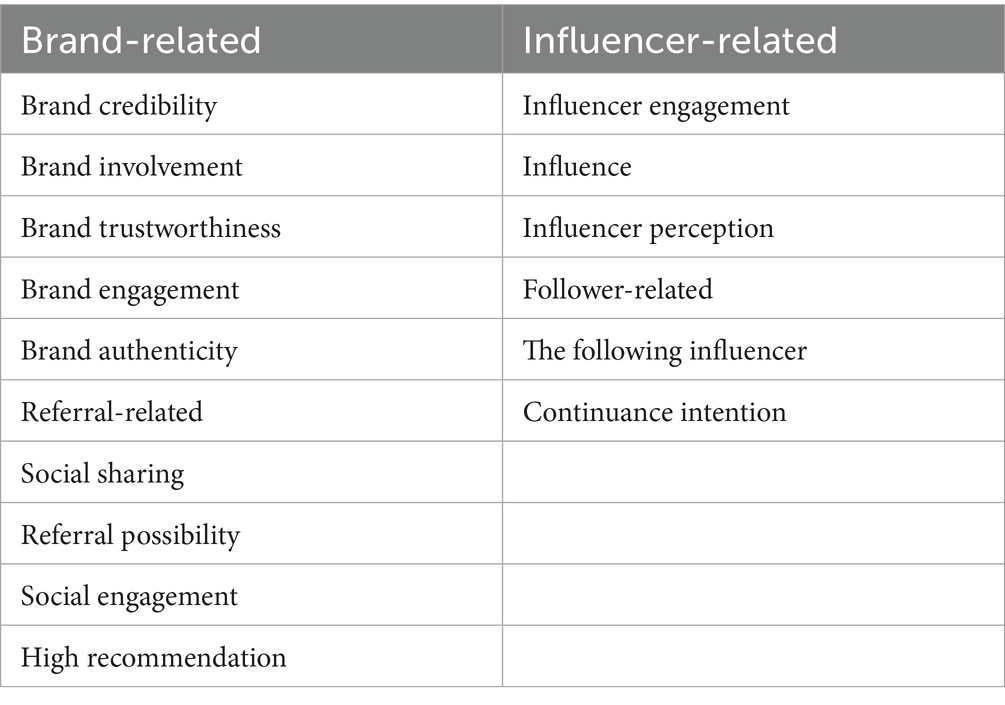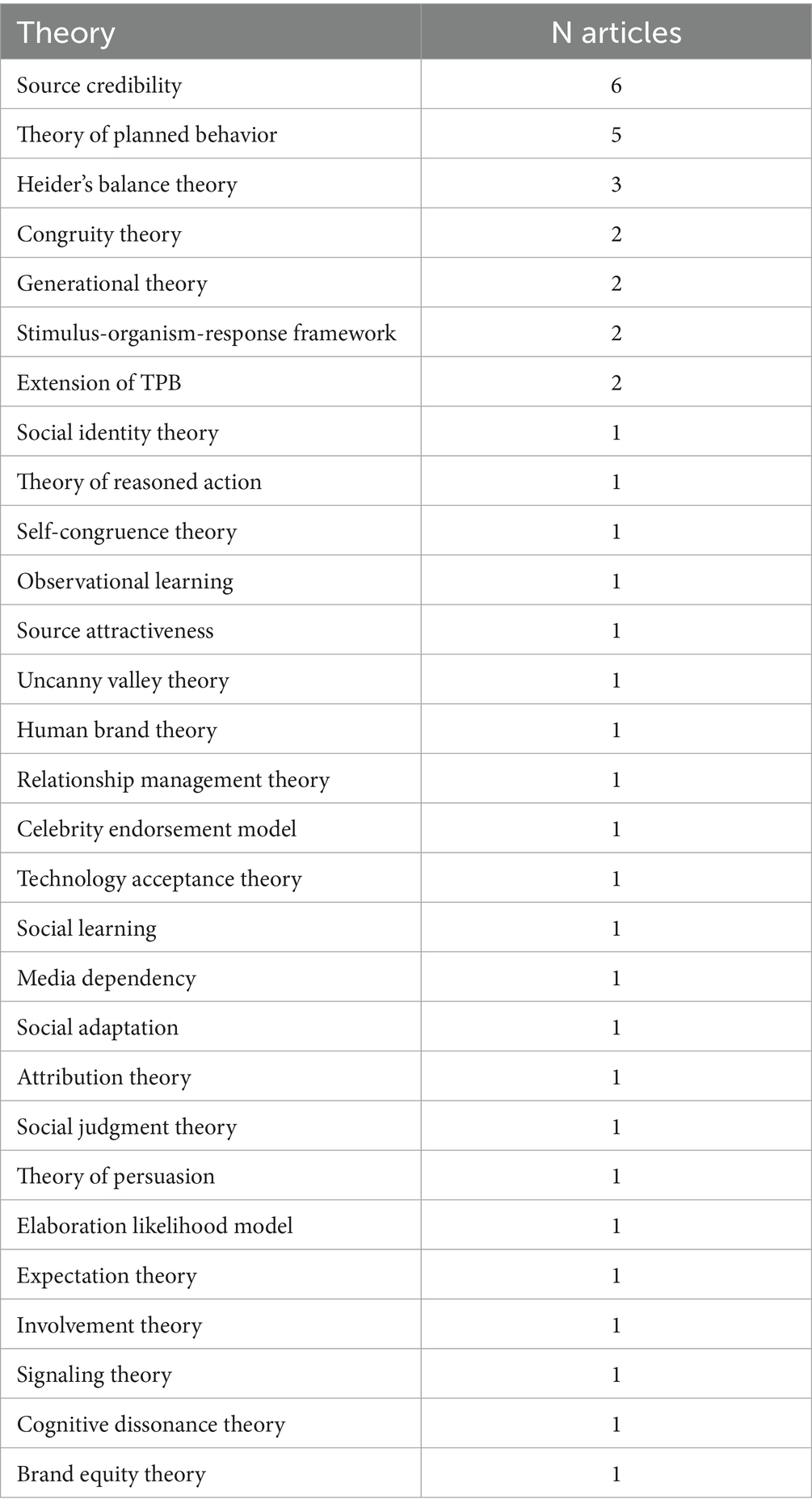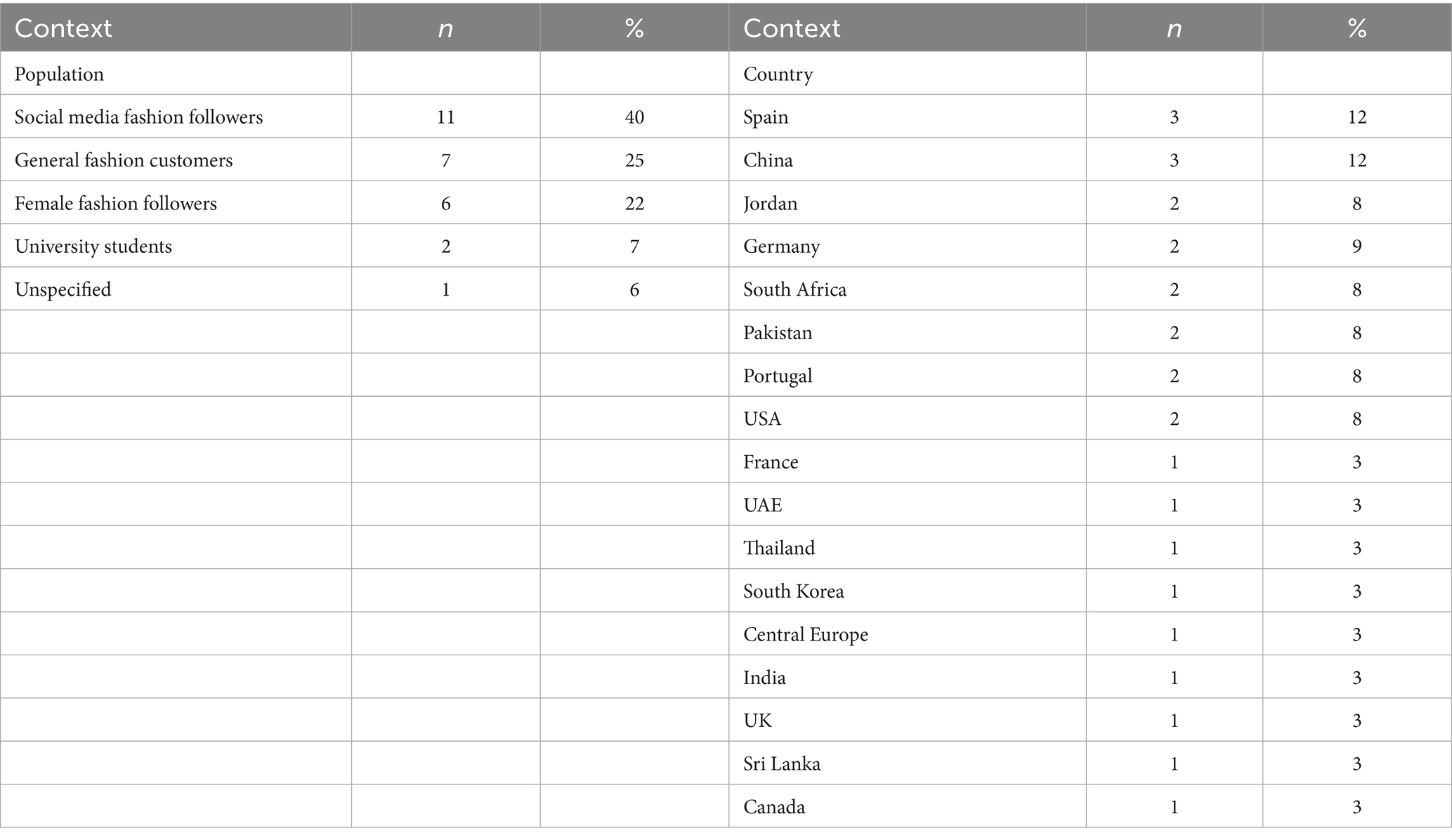- 1Marian College Kuttikkanam Autonomous, Kuttikkanam, India
- 2Nirmala College Muvattupuzha (Autonomous), Muvattupuzha, India
- 3Kuriakose Elias College, Mannanam, Kottayam, India
Introduction: Research on social media influencer marketing has grown significantly in recent decades, particularly in the fashion industry. This field is crucial for marketers, management, and influencers because of its strong influence on customer purchase decisions.
Methods: This systematic literature review employed the Preferred Reporting Items for Systematic Reviews and Meta-Analyses (PRISMA) framework to ensure a transparent and rigorous process for identifying and selecting relevant studies. To analyze and organize the findings, the ADO-TCM framework was applied, enabling a structured examination of antecedents, decisions, and outcomes (ADO), as well as the underlying theories, contexts, and methods (TCM) used in prior research.
Results: The review highlights credibility, trust, and attractiveness as the most frequently studied antecedents influencing the effectiveness of influencer marketing. Source credibility theory and the theory of planned behavior were identified as the dominant theoretical lenses guiding existing research.
Discussion: Despite the growth of scholarship in this area, significant gaps remain, particularly regarding contextual variations, methodological diversity, and emerging digital marketing trend. This study contributes by synthesizing fragmented research, identifying future research opportunities, and offering guidelines for marketers, management, and influencers. These insights aim to enhance the strategic use of influencer marketing and support customers in making informed purchase decisions in the dynamic fashion industry.
1 Introduction
Social media influencer (SMI) marketing is a new form of digital marketing in which social media influencers act as third parties and influence the attitude of followers by sharing the details of products and experiences (Saima and Khan, 2021). The increasing number of SMI followers highlights the importance of this marketing form (Chetioui et al., 2020), and the fashion industry has emerged as the most representative category (Joshi et al., 2023). An emerging area of research focuses on the convergence between social media and the fashion industry, with a special emphasis on the purchasing intention of customers toward fashion products, particularly among young people (Santiago et al., 2020). SMIs are creating both advantages and disadvantages for the followers. The harmful spread of wrong reviews of the products is also being assessed nowadays (Chetioui et al., 2020). Customers can be exposed to misleading information because of the dysregulated nature of social media (Haines et al., 2023). However, influencer trust and credibility play vital roles among customers in making perfect purchase decisions (Cabeza-Ramírez et al., 2022a; Shoukat et al., 2023). Influencers, through engaging content, credibility, and trust, are producing important information through social media and impacting the attitude and behavior of followers (Shoukat et al., 2023).
The occurrence of social media influencers and their role in spreading product information, influencing purchase behavior, and other factors is of high interest to the fashion industry, and this constitutes the current study (Shah et al., 2023). To date, there is no systematic literature study known to the authors that directly focuses on analyzing the impact of social media influencer marketing on customer purchase intention in the fashion industry. However, studies in the fields of tourism (Polat et al., 2024), healthcare (Powell and Pring, 2024), etc., were existed. By using a framework approach, we aim to answer the following research questions: (1) What do we know about social media influencer marketing in the fashion industry? (2) How do we know about social media influencer marketing in the fashion industry? (3) What are the future directions that can be drawn from social media influencer marketing research in the fashion industry? Before this research, we examined different study designs that assessed the impact of social media influencers in the fashion industry among young people (Cabeza-Ramírez et al., 2022a; Joshi et al., 2023; Renchen, 2020). For example, studying what influencers say about the fashion industry and products, investigating the trust and credibility of influencers, and how the messages are being conveyed to the customers (Wiedmann and Von Mettenheim, 2021). In addition, we also examined studies that address our central question of whether social media influencer marketing affects the purchase decision of customers in the fashion industry (Cabeza-Ramírez et al., 2022a; Gamage and Ashill, 2023; Haenlein et al., 2020). However, there was no previous systematic review answering this question, and therefore, no primary research to guide policy. Finally, two main contributions were made by this research to the literature: (1) By assessing the antecedents, decision, and outcome, the existing knowledge on social media influencer marketing is summarized, and (2) a research agenda is proposed to make future research fruitful.
The structure of the remaining paper is as follows. The review method is discussed in the following section. Sections 3 and 4 deal with the findings related to antecedents, decisions, outcomes, theories, contexts, and methods in social media influencer marketing. Sections 5 and 6 address the limitations and implications of this study. Finally, we present a future research agenda and concluding remarks at the end.
2 Review methods
Business research is growing rapidly, but it remains segmented and interdisciplinary. Literature review plays a vital role in research advancement and theory development. A systematic literature review is considered to be the most scientific and informative, as it is conducted in a well-justified manner (Paul et al., 2021). Therefore, this review uses a domain-based approach that focuses on a specific domain only. This study adopts the PRISMA framework to ensure a transparent and rigorous process for identifying and selecting relevant studies. After the screening process, 27 articles were retained for the final analysis. To synthesize the findings, the ADO–TCM framework was employed, which enabled a structured categorization of antecedents, decisions, and outcomes of social media influencer marketing in the fashion industry, while simultaneously examining the underlying theories, research contexts, and methodological approaches.
2.1 The ADO and TCM framework
Thematic reviews (Hao et al., 2019), theory-based reviews (Paul and Rosado-Serrano, 2019), and bibliometric analysis (Ruggeri et al., 2019) are different ways in which systematic reviews can be conducted. To understand the effect of social media influencer marketing on the purchasing intentions of customers in the fashion industry, an ADO and TCO dual framework was used. To understand how social media influencer marketing affects the purchasing behavior of fashion industry customers, the ADO framework is used (Paul and Criado, 2020). Here, “A” refers to antecedents, “D” refers to decision, and “O” refers to outcomes. Here, antecedents refer to the factors, reasons, and motivations that help a person engage in a behavior. “Decision” refers to the performance or non-performance factors that tell us how they engage in that behavior. The evaluation and other consequences that occur after the decision come under outcomes. The TCM framework is used here to answer the question of how we know what we know (Paul et al., 2017). Here, “T” refers to theories, “C” refers to contexts, and “M” refers to methods. Here, theories are the models used by the researchers, context refers to the background in which the construct is developed, and method refers to the approach used in the study. This combined framework was taken from Lim et al. (2021) and can reflect the strengths and overcome the weaknesses of the review.
2.2 Procedure
To identify the articles to be included in this literature review, the Preferred Reporting Items for Systematic Reviews and Meta-analysis (PRISMA) framework is used. The complete reporting of reviews systematically and transparently is possible using PRISMA (Liberati et al., 2009). The search criteria of prior research were assessed, and this study’s research methodology is adopted (Rosado-Serrano et al., 2018). The information is passed through three stages: identification, screening, and inclusion, which are presented in Figure 1 and explained in the following sections.
2.2.1 Identification of studies
Studies were identified from Scopus (n = 81) and the Web of Science (n = 52). Both these databases were used because of their popularity and because they list a larger number of articles. The search strategy used a keyword search in the title and the Boolean operator to combine the terms “Social media influencer marketing” AND “Fashion.” To ensure that the identification criteria met the objectives, journal identification was limited to “business,” “management,” “social science,” and “arts and humanities.” Duplicate articles were excluded from the initial stage (n = 19). Only journal articles were considered; conference proceedings, dissertations, review articles, etc., were removed; articles published before 2019 were excluded; and articles published between 2019 and 2024 were considered; here, n = 32. This timeframe was chosen because the number of articles published in these years on influencer marketing was high compared with previous years, as shown in Figures 2, 3.
2.2.2 Screening of studies
Two rounds of screening were conducted. All identified articles were first screened based on their titles. Titles that did not match the scope of this study or the social media platform effectiveness study were also excluded. This was followed by abstract screening. The abstracts of 55 articles were read to ensure that they met the abovementioned criteria. Disagreements were assessed, and 22 articles were excluded.
2.2.3 Inclusion of studies
Full data from 33 articles were extracted, and only 27 articles were included in the final stage. To confirm inclusion, an Excel spreadsheet was created to describe the study characteristics, objectives, methodology, and findings. One qualitative study and five articles that studied the impact of influencer marketing from the perspective of influencers were excluded. The results of the selected studies are discussed in the following sections.
3 What is currently known about social media influencer marketing in the fashion industry?
3.1 Antecedents
Antecedents are factors that affect or motivate customers’ decisions to purchase a product through social media influencer marketing in the fashion industry. Antecedents’ groups created are presented in Table 1, resulting in seven categories. Table 2 shows a list of 47 antecedents identified. Trust, credibility, and attractiveness are the three most researched antecedents. Trust is considered one of the strongest factors that influence the attitude of customers toward influencers, followed by credibility (Chetioui et al., 2020). Attractiveness can be social or physical. Physical and social attractiveness influence a customer’s decision in selecting an influencer, and there is a strong association between personal attributes and characterization (Hugh et al., 2022; Pereira et al., 2023). The greater the trustworthiness, the greater the attractiveness and credibility of the influencer; thus, it impacts the impulsive buying behavior of customers (Liu, 2022). The customers will be ready for more information if there exists trust and credibility (Gamage and Ashill, 2023).
3.1.1 Influencer-related antecedents
Under this subcategory, 23 items were identified. Influencer-related antecedents have been studied the most. Credibility, trust, and attractiveness were the most important factors, as described in the previous section. Other factors include risk, likability, commitment, conversation, and expertise (Al Masri et al., 2023; Almasri, 2023; Dhanesh and Duthler, 2019). The uncertainty that is felt by consumers when deciding to purchase a product constitutes risk (Cabeza-Ramírez et al., 2022b). To avoid this aspect of risk-taking felt by the consumers, open communication reflecting the perception and reflection of the brand is needed (Renchen, 2020). To propose open communication and enhance a proper influencer-follower relationship requires influencer expertise, and thus, consumers can also make a better product choice (Lu et al., 2024).
3.1.2 Audience-related antecedents
These antecedents play a vital role in strengthening consumer behavior toward purchasing fashion products. Attitude homophily, behavioral control, and emotional attachment are factors that encourage audiences to purchase products from influencers (Bevan-Dye and Motaung, 2023; Cabeza-Ramírez et al., 2022b; Shah et al., 2023). Attitude homophily refers to the interconnection and similarity felt by customers toward the influencer (Pereira et al., 2023). This similarity can create an emotional bond and affiliation between followers and influencers (Shoukat et al., 2023). Thus, it can lead followers to perform and display a particular behavior (Chetioui et al., 2020).
3.1.3 Technology-related antecedents
Technological factors can attract customers to purchase products through influencer marketing. In terms of designing and operating social media platforms, it is necessary to create a way to enhance their ease of use and perceived usefulness (Chen et al., 2023). Similarly, the presence of visual esthetics on the platform can also retain the customers of the influencer (Lu et al., 2024). Thus, positive interaction with the influencer is also possible (Jin et al., 2021).
3.1.4 Content-related antecedents
Content-related factors, including the quality of information, message authenticity, and usefulness of content, can build the perceived influence and purchase intention of followers. The fitness of using information provided by influencers can be assessed as the perceived quality of information (Shah et al., 2023). In addition, enhancing authenticity in the information conveyed can create a positive attitude toward the influencer’s recommendations (Cabeza-Ramírez et al., 2023).
3.1.5 Brand-related antecedents
Brand loyalty, awareness, and credibility are brand-related factors identified in studies that lead to the purchase intention of customers (Macheka et al., 2023). Through different market strategies and sponsored influencers, quality information is transmitted to customers, which constitutes brand credibility and thus has a positive relationship with purchase intention (Santiago et al., 2020).
3.1.6 Comparative-related antecedent
The alignment of the values and beliefs of followers with those of the influencer is based on a comparative factor (Hugh et al., 2022). This feeling of similarity toward the influencer can enhance the purchase intention of customers (Naderer et al., 2021).
3.1.7 Social-related antecedents
Studies have shown that parasocial relationships (ongoing relationships with influencers) can promote the purchase intention of customers (Hugh et al., 2022; Pereira et al., 2023). Such relationships and interactions by customers with the brand can lead to more favorable branded content (Jin et al., 2021). Moreover, online reviews (eWOM) are another social factor that influences consumer attitudes (Macheka et al., 2023) and helps social media influencers to increase buyer intent (Haines et al., 2023).
3.2 Decision
This section describes the different types of decisions taken by consumers with the involvement of different antecedents. Table 3 provides the categories created among the decisions, which are categorized into two categories, resulting in the 12 concepts presented in Table 4. Purchase intention and parasocial relationship-building decisions are the two most commonly studied decisions. Each category is described in the following section.
3.2.1 Purchase intention
Purchase intention refers to a consumer’s psychological state of buying (Chen et al., 2023). In the context of social media influencer marketing, the purchase intention of customers will be affected by different factors, such as credibility and authenticity (Cabeza-Ramírez et al., 2022b; Shoukat et al., 2023). The influencer’s brand and the brand being promoted must be aligned effectively and thus can affect the purchase intention of customers (Renchen, 2020). Marketers are considering purchase intention as a key determinant in purchase decisions (Chetioui et al., 2020).
3.2.2 Parasocial relationship
This is another decision made by consumers when they are satisfied with the factors affecting their psychological needs. Increased trustworthiness can thus be formed between the influencer and the customer, which also leads the customer to make a purchase decision (Jin et al., 2021).
3.3 Outcome
The findings related to outcomes will be presented in this section. Outcomes are what occur after a purchase decision is made. Four categories of outcomes were identified, and Table 5 shows 14 identified concepts. Influencer- and brand-related factors were already discussed in the section on antecedents. The remaining two categories are discussed in this section.
3.3.1 Referral-related outcome
Once the purchase decision is made, and if the consumers are satisfied, they will share the details of the products with others. This may result in higher recommendations (Belanche et al., 2021), social sharing, social engagement (Cabeza-Ramírez et al., 2022a; Macheka et al., 2023; Masuda et al., 2022), and better referral possibilities (Dhanesh and Duthler, 2019) and thus can improve the credibility (Saima and Khan, 2021) and authenticity (Hugh et al., 2022) of influencers.
3.3.2 Follower-related outcome
If the credibility of the message conveyed and its authenticity are worth customers, the probability of continuance intention toward the influencer may increase (Lu et al., 2024). This can help influencers in achieving trust and parasocial relationships among consumers (Jin et al., 2021).
4 How do we know about social media influencer marketing in the fashion industry?
4.1 Theories
Several theories are used in the field of social media influencer marketing to carry out studies. A total of 29 theories were identified from 27 articles. Table 6 shows all identified theories and their number of applicable articles. This huge number of theories indicates that for the last 5 years, researchers have used different theoretical frameworks for evaluating the purchase intention of fashion product customers through social media influencer marketing and there is no scarcity of theories for conducting future research in this field.
Source Credibility theory was the most popular theory (mentioned in 6 articles) (Cabeza-Ramírez et al., 2022b; Chetioui et al., 2020; Liu, 2022). This could be because, for many articles, credibility was the main antecedent noted before the purchase decision. The second and third most used theories were the theory of planned behavior (five articles) and Heider’s balance theory (three articles). The importance of using these theories to give legitimacy to their work can be understood by analyzing these articles. This section provides an overview of some of the widely used theories that have guided research in the field of influencer marketing in the fashion industry.
4.2 Source credibility theory
Applying this theory, Wiedmann and Von Mettenheim (2021) found that three variables of source credibility—attractiveness, trust, and expertise—play crucial roles in making customers buy products. Thus, the persuasive force of the sender is crucial and is positively impacted by source credibility (Cabeza-Ramírez et al., 2022a). Another study revealed that entertainment value and information quality may shape source credibility and motivate people to purchase products (Saima and Khan, 2021).
4.2.1 Theory of planned behavior
This theory is the extension of the theory of reasoned action (Ajzen, 1991) and is useful in understanding the buying behavior of fashion products by customers through influencer marketing (Cabeza-Ramírez et al., 2022b). According to this theory, attitude, subjective norms, and behavioral control are factors that affect the purchasing behavior of an individual (Liu, 2022). This establishes the relationship between these factors. This also suggests that a more positive attitude can create greater intention among consumers to buy a product (Cabeza-Ramírez et al., 2022a). Behavior directly determined by behavioral intent is another key aspect of this theory (Macheka et al., 2023).
4.2.2 Heider’s balance theory
Emotional attachment with influencers is another key antecedent in enhancing the purchase decision of customers (Shoukat et al., 2023). To enhance such an emotional attachment, a closer relationship with the influencer and a proper balance between endorser and message are necessary (Jin et al., 2021). (Wiedmann and Von Mettenheim, 2021) concluded that the endorser and the message can be connected with trust as a mediator, as per the balance model.
Apart from the above three theories, 26 other theories were mentioned in the above-selected articles. Most studies have integrated more than one theory into their research framework (Santiago et al., 2020; Wiedmann and Von Mettenheim, 2021), but some have tested theories in isolation (Cabeza-Ramírez et al., 2022b; Chetioui et al., 2020). Finally, 22% of (6/27) studies did not mention the application of any theory in their research.
4.3 Context
This refers to the surroundings in which the study is conducted (Paul and Criado, 2020). Considering the selected 27 articles, two main contexts were selected: population and geography (Table 7). In terms of population, 40% of the studies were conducted among social media fashion influencer followers, 25% were conducted among general fashion customers, and 22% were conducted among female fashion customers. This finding is not surprising, as all studies selected were considered from the perspective of customers only. Approximately 22% of studies are conducted among female customers, as they are more highly involved in fashion and beauty products than males (Gamage and Ashill, 2023). Next, in terms of geography, most studies on influencer marketing in the fashion industry have been conducted in Spain (11%) and China (11%). This factor is considerable, as other countries have only one or two studies in the selected papers. Only one study comes into sight from France, the UAE, Thailand, South Korea, Central Europe, India, the UK, Sri Lanka, and Canada. Therefore, these regions will require more attention in future studies. Countries were identified based on the respondent’s location and the first author’s location if the respondent’s location was not mentioned (Fetscherin and Usunier, 2012).
5 Methods
Research and data collection methods (Tables 8, 9) are considered the basis for assessing this section. In terms of the data collection method, 85% of the studies (23/27) were conducted using the survey method with circulating questionnaires. Online and offline modes were used in these surveys. In terms of research methods, 96% of the studies (26/27) were quantitative, and only one study was conducted using an exploratory descriptive research method. Qualitative studies were excluded from this review during the screening stage.
6 Systematic literature limitations
This review only included studies from SCOPUS and the Web of Science database, which belong to the years 2019–2024. There were publications before 2019 that might add insights. Conference proceedings, theses, dissertations, and articles not in the English language were excluded. Qualitative studies and those from the perspective of influencers were excluded. Content quality and feasibility were selected as the basis for these studies, and some useful studies may exist.
7 Implications
This is the first systematic literature study known to the authors that focuses on analyzing the direct impact of purchase intention on customers in the fashion industry through social media influencer marketing. Most research has focused on the credibility of influencers and attitudes of customers from the theoretical perspectives of the source credibility theory and the theory of planned behavior. The majority of the antecedents identified were studied based on the characteristics of the influencer, and thus, the impact was measured. In the case of the population and context of prior research, some limitations were identified, as the scope was scattered across different areas. By focusing more on youngsters and developing countries, this gap can be addressed. To make further research fruitful in the field of marketing, six gaps were identified in the studies. By analyzing the gaps, more marketing-related antecedents can be included; thus, influencers can concentrate more on the quality of products. The crucial role of SMEs in impacting the purchase decision of consumers, which includes credibility, attitude, and parasocial relationship, should be considered by scholars while addressing the research gaps. More responsible research can be used to understand the shift from the importance of social media influencer marketing to protecting this form of marketing. This research can help marketers by spreading the information about the quality of their products.
In this competitive world, many influencers, managers, and brands in the fashion industry can make appropriate choices in selecting influencers based on the results of this study. While selecting the influencer, congruence between the influencer and the audience should exist, and it should also create positive consequences for the company. If a company wants to target a specific segment of the market, the influencer must be selected accordingly. Thus, it can be said that consumers are getting influenced by the brands indirectly through the influencers. While considering the antecedents, it is clear that brand-related antecedents were comparatively fewer, as they include their importance through the characteristics of the influencer. Consumer behavior is directly influenced by influencers through brand promotion. The content quality that they demonstrate through their promotions determines how customers respond to these stakeholders. Therefore, companies should provide appropriate guidance to influencers to advertise product information. In addition to content-related factors, the credibility of the influencer, authenticity, transparency, etc., can also affect the purchasing behavior of customers. Additionally, by considering the influencer-related antecedents reviewed in this study, marketers can choose the best influencer for marketing purposes.
8 Concluding remarks
From this research, we hope to inspire future studies on social media influencer marketing in the fashion industry. Several aspects of social media influencer marketing, the fashion industry, and purchase intention can be assessed by exploring this domain in the future. Through this review, it is noted that the number of studies on social media influencer marketing is increasing. Therefore, by including more marketing-related antecedents and other dimensions, this study can be explored further in the future. A proper shift to this dimension can help marketers and policymakers, as well as consumers, in making better decisions related to the products they purchase through social media influencers.
9 Future research directions
From the review of the antecedents, decisions, outcomes, theories, contexts, and methodologies of the 27 articles published in different journals, 6 important research gaps were identified and are discussed in the following section.
9.1 Decisions made by fashion industry customers as a result of social media influencer marketing can be expanded into other decisions
One of the most significant research gaps identified was that the decisions taken by customers through social media influencer marketing were limited to the purchase intention in the majority of studies. Other areas, such as motivation to become an influencer, brand loyalty, sharing the details of the influencer, following the influencer, sustainable purchase, and complete shifting from offline purchase to online purchase, should be considered for future research. For example, few studies have only focused on the role of sustainability through social media influencer marketing (Liu, 2022). Sustainable purchase is an important aspect nowadays, and thus it should be explored in future studies.
9.2 Inclusion of marketing elements as antecedents in social media influencer marketing
The next research gap identified was the lack of studies on marketing-related antecedents motivating customers to purchase products. Influencer-related antecedents were assessed in all the articles. Product-, price-, promotion-, and place-related factors may also contribute to the purchase intention of customers; thus, these factors should be explored in future studies. Price- and place-related factors can be considered the most important factors to be explored. The relationship between perceived value, price, and purchase intention of customers through social media influencer marketing in the fashion industry will be an interesting area of study. On the other hand, a study of the role of distribution channels in affecting the purchase behavior of customers through social media influencer marketing is also crucial. Product features are explored a little (Almasri, 2023) in the form of the qualities of the product and its usefulness. Promotional factors, such as social engagement (Belanche et al., 2021) and referral possibility, are also discussed (Shoukat et al., 2023), but more factors can be explored.
9.3 In-depth understanding of the purchase decision consequences
The lack of outcomes and consequences is identified as the next research gap. What are the consequences that customers face when they decide to purchase products? What are the advantages and disadvantages that customers consider when they decide to follow an influencer? Answers to these questions were not found in any of the studies. Future studies would benefit from exploring these areas.
9.4 Avoid scattering of theories
The next gap identified is the scattered use of theories. A total of 29 theories were identified from the 27 articles using the TCM framework. By exploring the mediating and moderating variables, key theories can be identified in future studies to gain a better understanding. Thus, the purchase intention of the customers can be tested using these key theories. Another recommendation is to use theories that are more relevant to the field of social marketing.
9.5 Exploration of wide context and culture
In most studies, only a particular area or culture is selected. However, in future studies, a comparison between different countries and cultures should be performed. Most studies are conducted in China (Chen et al., 2023) and Spain (Cabeza-Ramírez et al., 2022a; Cabeza-Ramírez et al., 2022b) and thus show the concentration of studies in developed and developing countries. In future research, underdeveloped countries should also be considered.
9.6 Target group expansion
The sixth research gap identified is that the research should focus on more diversified groups. From this literature review, it is evident that most of the studies are conducted on female groups (Cabeza-Ramírez et al., 2022a; Gamage and Ashill, 2023; Haines et al., 2023; Jin et al., 2021; Naderer et al., 2021; Wiedmann and Von Mettenheim, 2021) and youth (Al Masri et al., 2023; Almasri, 2023; Cabeza-Ramírez et al., 2022b; Santiago et al., 2020). In the future, studies should be conducted among other gender and age groups. Other developing countries can also be explored.
Data availability statement
The original contributions presented in the study are included in the article/supplementary material, further inquiries can be directed to the corresponding author.
Author contributions
AG: Writing – review & editing. MS: Writing – original draft. EJ: Formal analysis, Methodology, Writing – review & editing. PS: Formal analysis, Methodology, Writing – review & editing.
Funding
The author(s) declare that no financial support was received for the research and/or publication of this article.
Conflict of interest
The authors declare that the research was conducted in the absence of any commercial or financial relationships that could be construed as a potential conflict of interest.
Generative AI statement
The authors declare that no Gen AI was used in the creation of this manuscript.
Any alternative text (alt text) provided alongside figures in this article has been generated by Frontiers with the support of artificial intelligence and reasonable efforts have been made to ensure accuracy, including review by the authors wherever possible. If you identify any issues, please contact us.
Publisher’s note
All claims expressed in this article are solely those of the authors and do not necessarily represent those of their affiliated organizations, or those of the publisher, the editors and the reviewers. Any product that may be evaluated in this article, or claim that may be made by its manufacturer, is not guaranteed or endorsed by the publisher.
References
Ajzen, I. (1991). The theory of planned behaviour. Organ. Behav. Hum. Decis. Process. 50, 179–221. doi: 10.1016/0749-5978(91)90020-T
Al Masri, Y., Hamadneh, S., Al-Dmour, R., and Al-Okaily, M. (2023). Can computer virtual influencers replace human influencers in the future? An empirical investigation in the age of digital transformation. Jordan J. Bus. Adm. 19, 498–513. doi: 10.35516/jjba.v19i4.1430
Almasri, Y. (2023). Fashion virtual influencers: antecedents influencing females’ behavioral intentions in Jordan. Dirasat Hum. Soc. Sci. 50, 390–402. doi: 10.35516/hum.v50i3.5420
Belanche, D., Casaló, L. V., Flavián, M., and Ibáñez-Sánchez, S. (2021). Understanding influencer marketing: the role of congruence between influencers, products and consumers. J. Bus. Res. 132, 186–195. doi: 10.1016/j.jbusres.2021.03.067
Bevan-Dye, A., and Motaung, L. G. (2023). Ascertaining the antecedents of generation Y consumers’ perceived utility of celebrity influencers’ fashion content on Instagram and consequent fashion brand predispositions and purchase intentions. Innov. Mark. 19, 81–94. doi: 10.21511/im.19(4).2023.07
Cabeza-Ramírez, L. J., Fuentes-García, F. J., Cano-Vicente, M. C., and González-Mohino, M. (2022a). How generation X and millennials perceive influencers’ recommendations: perceived trustworthiness, product involvement, and perceived risk. J. Theor. Appl. Electron. Commer. Res. 17, 1431–1449. doi: 10.3390/jtaer17040072
Cabeza-Ramírez, L. J., Sánchez-Cañizares, S. M., Santos-Roldán, L. M., and Fuentes-García, F. J. (2022b). Impact of the perceived risk in influencers’ product recommendations on their followers’ purchase attitudes and intention. Technol. Forecast. Soc. Change 184:121997. doi: 10.1016/j.techfore.2022.121997
Cabeza-Ramírez, L. J., Sánchez-Cañizares, S. M., Santos-Roldán, L. M., and Fuentes-García, F. J. (2023). Exploring the effectiveness of fashion recommendations made by social media influencers in the centennial generation. Text. Res. J. 93, 3240–3261. doi: 10.1177/00405175231155860
Chen, H., Wareewanich, T., and Chankoson, T. (2023). Influencing factors of Chinese millennial consumers’ online purchase intentions via following influencers’ recommendations: an empirical study on womenswear market. J. Syst. Manag. Sci. 13, 426–444. doi: 10.33168/JSMS.2023.0514
Chetioui, Y., Benlafqih, H., and Lebdaoui, H. (2020). How fashion influencers contribute to consumers’ purchase intention. J. Fashion Mark. Manag. 24, 361–380. doi: 10.1108/JFMM-08-2019-0157
Dhanesh, G. S., and Duthler, G. (2019). Relationship management through social media influencers: effects of followers’ awareness of paid endorsement. Public Relat. Rev. 45:101765. doi: 10.1016/j.pubrev.2019.03.002
Fetscherin, M., and Usunier, J. (2012). Corporate branding: an interdisciplinary literature review. Eur. J. Mark. 46, 733–753. doi: 10.1108/03090561211212494
Gamage, T. C., and Ashill, N. J. (2023). # sponsored-influencer marketing: effects of the commercial orientation of influencer-created content on followers’ willingness to search for information. J. Prod. Brand. Manag. 32, 316–329. doi: 10.1108/JPBM-10-2021-3681
Haenlein, M., Anadol, E., Farnsworth, T., Hugo, H., Hunichen, J., and Welte, D. (2020). Navigating the new era of influencer marketing: how to be successful on Instagram, TikTok, & co. Calif. Manag. Rev. 63, 5–25. doi: 10.1177/0008125620958166
Haines, S., Fares, O. H., Mohan, M., and Lee, S. H. (2023). Social media fashion influencer eWOM communications: understanding the trajectory of sustainable fashion conversations on YouTube fashion haul videos. J. Fash. Mark. Manag. 27, 1027–1046. doi: 10.1108/JFMM-02-2022-0029
Hao, A. W., Paul, J., Trott, S., Guo, C., and Wu, H.-H. (2019). Two decades of research on nation branding: a review and future research agenda. Int. Mark. Rev. 38, 46–69. doi: 10.1108/IMR-01-2019-0028
Hugh, D. C., Dolan, R., Harrigan, P., and Gray, H. (2022). Influencer marketing effectiveness: the mechanisms that matter. Eur. J. Mark. 56, 3485–3515. doi: 10.1108/EJM-09-2020-0703
Jin, S. V., Ryu, E., and Muqaddam, A. (2021). I trust what she’s #endorsing on Instagram: moderating effects of parasocial interaction and social presence in fashion influencer marketing. J. Fash. Mark. Manag. 25, 665–681. doi: 10.1108/JFMM-04-2020-0059
Joshi, Y., Lim, W. M., Jagani, K., and Kumar, S. (2023). Social media influencer marketing: foundations, trends, and ways forward. Electron. Commer. Res. 25, 1199–1253. doi: 10.1007/s10660-023-09719-z
Liberati, A., Altman, D. G., Tetzlaff, J., Mulrow, C., Gotzsche, P. C., Ioannidis, J. P. A., et al. (2009). The PRISMA statement for reporting systematic reviews and meta-analyses of studies that evaluate healthcare interventions: explanation and elaboration. Br. Med. J. 339:b2700. doi: 10.1136/bmj.b2700
Lim, W. M., Yap, S.-F., and Makkar, M. (2021). Home sharing in marketing and tourism at a tipping point: what do we know, how do we know, and where should we be heading? J. Bus. Res. 122, 534–566. doi: 10.1016/j.jbusres.2020.08.051
Liu, M. (2022). Determining the role of influencers’ marketing initiatives on fast fashion industry sustainability: the mediating role of purchase intention. Front. Psychol. 13:940649. doi: 10.3389/fpsyg.2022.940649
Lu, H.-H., Chen, C.-F., and Tai, Y.-W. (2024). Exploring the roles of vlogger characteristics and video attributes on followers’ value perceptions and behavioral intention. J. Retail. Consum. Serv. 77:103686. doi: 10.1016/j.jretconser.2023.103686
Macheka, T., Quaye, E. S., and Ligaraba, N. (2023). The effect of online customer reviews and celebrity endorsement on young female consumers’ purchase intentions. Young Consum. 25, 462–482. doi: 10.1108/YC-05-2023-1749
Masuda, H., Han, S. H., and Lee, J. (2022). Impacts of influencer attributes on purchase intentions in social media influencer marketing: mediating roles of characterizations. Technol. Forecast. Soc. Change 174:121246. doi: 10.1016/j.techfore.2021.121246
Naderer, B., Matthes, J., and Schäfer, S. (2021). Effects of disclosing ads on Instagram: the moderating impact of similarity to the influencer. Int. J. Advert. 40, 686–707. doi: 10.1080/02650487.2021.1930939
Paul, J., and Criado, A. R. (2020). The art of writing literature review: what do we know and what do we need to know? Int. Bus. Rev. 29:101717. doi: 10.1016/j.ibusrev.2020.101717
Paul, J., Lim, W. M., O’Cass, A., Hao, A. W., and Bresciani, S. (2021). Scientific procedures and rationales for systematic literature reviews (SPAR-4-SLR). Int. J. Consum. Stud. 45, 1–16. doi: 10.1111/ijcs.12695
Paul, J., Parthasarathy, S., and Gupta, P. (2017). Exporting challenges of SMEs: a review and future research agenda. J. World Bus. 52, 327–342. doi: 10.1016/j.jwb.2017.01.003
Paul, J., and Rosado-Serrano, A. (2019). Gradual internationalization vs born-global/international new venture models: a review and research agenda. Int. Mark. Rev. 36, 830–858. doi: 10.1108/IMR-10-2018-0280
Pereira, M. J. S., Cardoso, A., Canavarro, A., Figueiredo, J., and Garcia, J. E. (2023). Digital influencers’ attributes and perceived characterizations and their impact on purchase intentions. Sustainability 15. doi: 10.3390/su151712750
Polat, E., Celik, F., Ibrahim, B., and Gursoy, D. (2024). Past, present, and future scene of influencer marketing in hospitality and tourism management. J. Travel Tourism Mark. 41, 322–343. doi: 10.1080/10548408.2024.2317741
Powell, J., and Pring, T. (2024). The impact of social media influencers on health outcomes: systematic review. Soc. Sci. Med. 340:116472. doi: 10.1016/j.socscimed.2023.116472
Renchen, K. D. (2020). Influencer impact on brand awareness: a mixed method survey in the German fashion segment. Eur. J. Bus. Sci. Technol. 6, 138–153. doi: 10.11118/ejobsat.2020.009
Rosado-Serrano, A., Paul, J., and Dikova, D. (2018). International franchising: a literature review and research agenda. J. Bus. Res. 85, 238–257. doi: 10.1016/j.jbusres.2017.12.049
Ruggeri, G., Orsi, L., and Corsi, S. (2019). A bibliometric analysis of the scientific literature on Fairtrade labelling. Int. J. Consum. Stud. 43, 134–152. doi: 10.1111/ijcs.12492
Saima,, and Khan, M. A. (2021). Effect of social media influencer marketing on consumers’ purchase intention and the mediating role of credibility. J. Promot. Manag. 27, 503–523. doi: 10.1080/10496491.2020.1851847
Santiago, J., Magueta, D., and Dias, C. (2020). Consumer attitudes towards fashion influencers on instagram: impact of perceptions and online trust on purchase intention. Issues Inf. Syst. 21, 105–117. doi: 10.48009/1_iis_2020_105-117
Shah, S. A., Shoukat, M. H., Jamal, W., and Shakil Ahmad, M. (2023). What drives followers-influencer intention in influencer marketing? The perspectives of emotional attachment and quality of information. SAGE Open 13:21582440231179712. doi: 10.1177/21582440231179712
Shoukat, M. H., Selem, K. M., and Asim Shah, S. (2023). How does social media influencer credibility blow the promotional horn? A dual mediation model. J. Relatsh. Mark. 22, 172–201. doi: 10.1080/15332667.2023.2197767
Keywords: social media, influencer, influencer marketing, fashion industry, marketing, systematic literature review
Citation: George A, Shibu M, Joseph ET and Sunny P (2025) Impact of social media influencer marketing on customer purchase intention in the fashion industry: a systematic literature review. Front. Commun. 10:1676901. doi: 10.3389/fcomm.2025.1676901
Edited by:
Galina Ilieva, Plovdiv University “Paisii Hilendarski,” BulgariaReviewed by:
Muhammad Bilawal Khaskheli, Dalian University, ChinaTatyana Bastrygina, Swinburne University of Technology, Australia
Copyright © 2025 George, Shibu, Joseph and Sunny. This is an open-access article distributed under the terms of the Creative Commons Attribution License (CC BY). The use, distribution or reproduction in other forums is permitted, provided the original author(s) and the copyright owner(s) are credited and that the original publication in this journal is cited, in accordance with accepted academic practice. No use, distribution or reproduction is permitted which does not comply with these terms.
*Correspondence: Ajimon George, bWlsY2FobWFyaWFuQGdtYWlsLmNvbQ==
†ORCID: Milcah Shibu, orcid.org/0000-0002-4635-7289
 Ajimon George1*
Ajimon George1* Milcah Shibu
Milcah Shibu